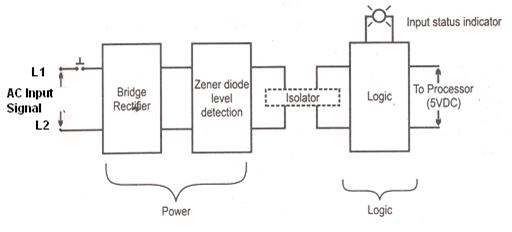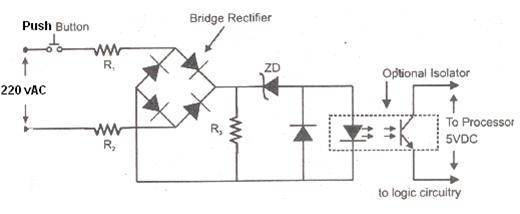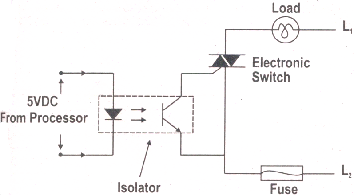Programmable Logic Controller - PLC
PLC stands for programmable logic control. It is computer designed to be used in industry. It controls the different process and is programmed According to the operational requirement of that process.
Several industries utilize sequential industrial process which is respective in nature. For such processes industries have to depend upon use of relays, stepping drum, timers and controls considerable difficulties experienced in reprogramming necessitated due to change in the nature of production. Often the whole system has to be scrapped and a redesigned is required.
To overcome these problems PLC control system was introduced. The PLC can be described as a control ladder comprising a sequence program.PLC sequence program consists of normally open and normally closed contacts connected in parallel or in series. It also has relay coils, which turns ON and OFF as the state of these contacts change.
PLC Programmable Logic Concept
Programmable logic controller is a microprocessor based programming technique, which is used to perform many functions in industrial process. Programmable logic controller operates similar to the ordinary controller. But in this system different operation are performed by software. If we want to change program it is only needed to change the program in the software. PLC takes input instructions in the form of ladder diagram or computer software instructions.
These instructions are decoded in CPU and CPU provides differed signals to control or to operate many devices of system.
When these devices change their position or cause to change controlled variable. A sample of controlled variable is given to CPU indicate that change in controlled variable has been eliminated. PLC basically consists of a ladder network, which is performed according requirements of the system.
Basic Parts of the PLC
A typical block diagram of PLC is show in Fig. as clear from fig PLC consists of following basic parts.
- CPU (Central processing unit)
- Programming device
- Input & output module.

PLC Block Diagram
The central processing unit is the heart of the PLC system. The CPU is a microprocessor based control system that replaces central relays, counters, timers and sequencers. A processor appears only once in a PLC and it can be either a one-bit or a word processor. One bit processors are adequate for dealing with logic operations. PLCs with word processors are used when processing text and numerical data, calculations, gauging, controlling and recording, as well as the simple processing of signals in binary code are required.
The principle of operation of CPU can be briefly described as fallow.
- The CPU accepts (reads) input data from various sensing devices, executes the user program from memory and sends appropriate output commands to control devices.
- A direct current (DC) power source is required to produce the low-level voltage used by processor and I/O modules. This power supply can be housed in the CPU unit or may be a separately mounted unit, depending on the PLC system manufactures. The CPU contains various electrical parts and receptacles for connecting the cables that go to the other units as well as to operational key switches.
Typical operation key switch positions are.
- Off: system cannot be run or programmed.
- Run: allow the system to run, but no program alterations can be made.
- Program: disables output and allows creating modifying, and deleting of programs.
Input & Output Modules of PLC
Input/output modules are used for interfacing between input devices (e.g start and stop push buttons, sensers, limited switch, selector switch) and microprocessor. And also used for interfacing between output devices (e.g electrical heater, lights, solenoid valve, relays, buzzer, fan) and microprocessor. The input information is transfer to the processor through input module and output information from the processor to load is transform through output module.
The input/output module use for providing the isolation between input devices and process. And also to provide isolation from processor to output devices. For isolation modules use the opto coupler.
Input devices such as push buttons, limited switches, sensors and selector switches are hard-wired to terminals on the input modules. Output devices such as small motor, motor starters, solenoid valve, and indictor lights are hard wired to the output modules.
Input interface modules accept signals from the machine or process devices (e.g 220V AC) and convert them into signals (e.g 5VDC) that can be used by the controller, or processor output interface modules converts controller or processor signals (e.g 5VDC) into external signals (e.g 220 v AC) used to control the machine or process.
The simplified circuit and block diagram of input modules is shown in fig. input modules perform four basic tasks in PLC system.
- They sense when signal is received form the sensor on the input of the machine,
- They convert the input voltage to the correct voltage level for the PLC
- They isolate PLC from fluctuation in the input signal voltage or current.
- At end they send the signal to the PLC.


It is clear form the above figure that the input module is consist of two section one is power section while the other is logical section, which are electrically isolated from each other. When push button is closed 220V AC is applied to the bridge rectifier, through resisters R1 & R2. rectifier convert AC Signal into DC signal and zener diode ZD gives low voltage to the LED. When light from LED strikes the phototransistor it become in conduction region and give DC voltage to the processor. Optical isolator also helps to reduce the effects of electrical noise, which can produce error.
PLC Output Module
Output module is use for interfacing between output load and processor, the output modules has a function similar to that of the input modules except in reverse order.
The fig shown the block and circuit diagram of output module. It consists of two sections, one is logic section second is power section.

When logic high signal comes from the processor the LED is on & light strike to phototransistor. Which become in conduction region & give a triggering pulse to at the gate of triac. The triac conducts-and load lamp is energized through it as clear from fig.
The interfacing is providing by opto-coupler (LED, Phototransistor) as in the input module.

Programming device (Keyboard Monitor)
Keyboard and monitor is used for programming a PLC. The data is inter in the PLC processor with the help of Keyboard in the form of ladder diagram. This ladder diagram can be see on the monitor screen. The programmer can communicate with PLC processor with help of programming devices. The programming unit communicates with processor if PLC via a serial or parallel data communication link. The personal computer can be used for programming of PLC if it has required software.
Micro processor Based PLC Control System
The Figure shows the block diagram of microprocessor based control system. Data acquisition system (DAS) takes information signals form sensor which is in the form of analog and change it into digital value which can be read in and processed by the microprocessor. A key-board and display in the system allow the user to set-point values, to read the current values of process variables, and issue commands. Relays, D/A converters,

Solenoid valves and other actuators are used to control process variables under program direction. A programmable timer in the system determines the rate at which control loops are serviced.
Microprocessor-based control system range from a small Programmable controller which might be used to control a machine on Factory floor to large computers used to control an entire fractionating column in an oil refinery.
